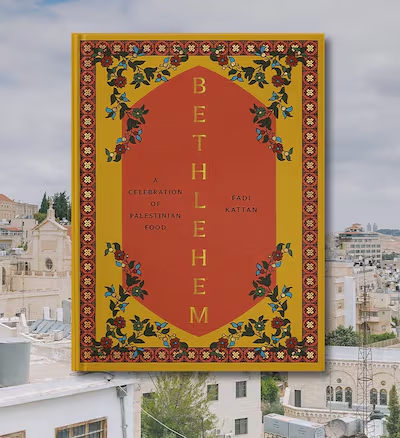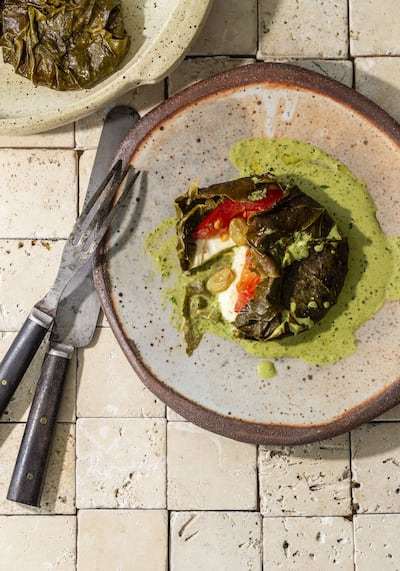Palestinian chef Fadi Kattan has shared one of his new recipes with The National, ahead of the release of his first cookbook, Bethlehem.
There's no better time to celebrate Palestinian food than now, says the chef, who started his culinary journey in his grandmother's kitchen and now has a restaurant in London called Akub. His cookbook, which will be released on May 16, is a poignant symbol of his hopes and dreams for his people, written in the most personal of ways.
“I want this to get a bit of Palestinian sunshine in everybody's home,” he tells The National, adding that he aims to shed light on the country's food culture and bring “pleasure to people”.
Recipes are divided by season, and other recipes in the book include eggs in samneh with sumac and lamb shanks for spring; fig jam, shawarma and watermelon salad from summer; lentil soup and cauliflower makloubeh from autumn; and makloubeh freekeh risotto and Christmas cake from winter.

Fadi Kattan's cheese-stuffed grape leaves
Serves 2
"This recipe is inspired by my mother’s moreish meat kofta in grape leaves. By substituting akkawi or Nabulsi cheese for the meat, it makes an easy starter, perfect for vegetarians," Kattan writes in Bethlehem.
"Grape leaves are a key ingredient in Palestinian cuisine. They are usually rolled and stuffed with meat and rice, or just rice and herbs, or are wrapped around meat patties. I am always impressed at the speed and expertise of Palestinian women as they roll the leaves into piles of delicious, tiny parcels.
"Both akkawi and Nabulsi are fresh cheeses stored in brine. The mixture in the grape leaves includes the perennial herb zaatar. You may know zaatar as a spice blend, but it is also an herb, also called origanum syriacum."

Ingredients
20 fresh grape leaves (or substitute leaves stored in a brine)
1 tablespoon raisins
Olive oil, for brushing
150 g of akkawi or Nabulsi cheese (or substitute another fresh brined cheese, such as halloumi, fresh Syrian cheese, or queso blanco)
2 small tomatoes, thinly sliced
3 tablespoons dried and crumbled zaatar leaves (or substitute oregano)
2 tablespoons extra virgin olive oil
1 pinch of salt
Leaves of five sprigs of fresh mint or fresh zaatar, or other green herb of choice
2 drops of water (optional)
Method
To make the parcels, if you’re using fresh grape leaves, blanch the whole leaves in a large pot of lightly salted water until they turn a deep green and are soft to the touch, five to seven minutes, depending on the thickness of the leaves. Drain well.
Put the raisins in a bowl filled with enough warm water to cover them, because we need to hydrate them slightly.
Brush 10 little ramekins, 5cm to 7cm / 2 to 3 inches in diameter, with a bit of olive oil. Place two grape leaves in each one, with the top side downwards so that when we flip the ramekin, we’ll end up with the outside of the leaves facing up.
Cut the cheese into 10 equal portions. Drain the raisins.
Put one piece of cheese, a slice of tomato, a few raisins, and a bit of zaatar leaves on the grape leaves. Fold the leaves to enclose the filling in the ramekins.
Preheat the oven to 160°C / 325°F. Place the ramekins in a roasting pan and fill the pan with water to the height of the grape leaves in the ramekins.
Cover the top of the ramekins with a baking sheet; we don’t want the grape leaves to dry out.
Bake for 20 minutes. Remove the ramekins from the water bath and let cool.
When you’re ready to serve, flip the ramekins onto plates to see the beautiful stuffed grape leaves.
To make the dressing, combine the olive oil, salt, and herbs in a blender and process to a homogenous green sauce. Add the water to thin the dressing, if needed. Sprinkle it on top of the grape leaves and serve.







